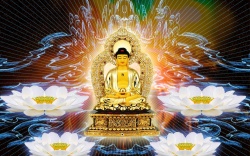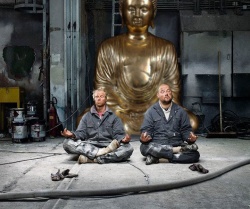Kasina Meditation
Kasina meditation is a form of concentration meditation.
This form of reflection is meant to settle the mind of the meditation practitioner.
Kasina meditation also allows for the creation of a foundation for more advanced meditation practices.
In Therevada Buddhism, forty visual objects suitable for meditation are listed.
Ten of these forty are referred to as kasinas.
These kasinas are the concepts of earth, water, fire, wind, the colors blue, red, yellow and white, and the ideas of enclosed space and bright light or consciousness.
Contemplation on one of these kasinas allows the meditator to reach states of rapture referred to as jhanas.
Kasina are generally presented as colored disks with the particular properties of the desired type of kasina.
An earth kasina would be a reddish brown disk created by spreading clay, earth, or similar material onto a backing material.
During the practice of kasina meditation, each practitioner uses their own kasina.
Because of this, the practice is difficult to teach in groups.
The environment is to be devoid of other visual stimulation, to prevent distraction.
Because of these factors, it can be difficult to find teaching in the use of kasina objects outside of traditional Buddhist practice.
As with any method of meditation, there are advantages and disadvantages to the kasina practice of rumination.
The advantages of this kasina meditation include the clear and specific definitions of the visual object.
For a beginner, these concrete qualities can make the attainment of a serene state of thought less difficult.
A drawback to kasina is that the devices used for deliberation can be cumbersome to transport and inconvenient to make.
Another problem is the possibility of eye strain created by consideration of the kasina object.
Should problems of this sort begin to occur, it is important to try not to cease the meditation.
During the regular periods that the eyes are closed in kasina meditation, they will feel some relief.
The amount of time that should be spent on kasina meditation varies between subjects.
The amount of time normally spent on other meditations should suffice for kasina meditation.
Initially, a teacher for this practice should be consulted, but after this, solitary practice is permitted.
Several kasina devices and a suitable place for practice must be found before meditation can begin.
The meditator should assume a comfortable sitting position, approximately one and a half to three yards from the kasina object.
Meditation should be on the center of the colored image, not on the border or outside distractions.
It is acceptable to blink the eyes to reduce fatigue.
Once focus on the kasina has been established, verbalization is abandoned and only the nature of the kasina considered.
All other thoughts or sensory experiences must be avoided when practicing kasina meditation.
By Rob Gerrard
Source
http://www.project-meditation.org/a_mt2/kasina_meditation.html



